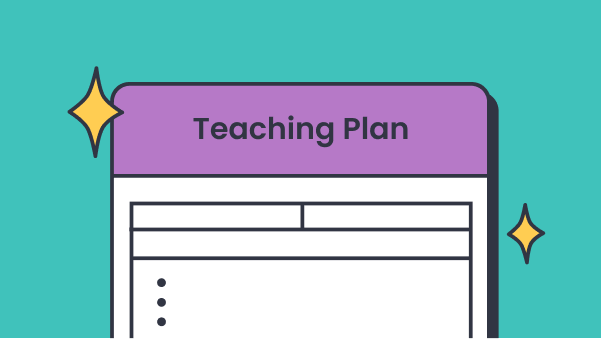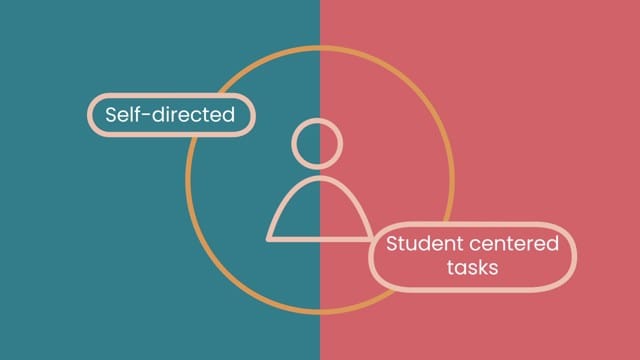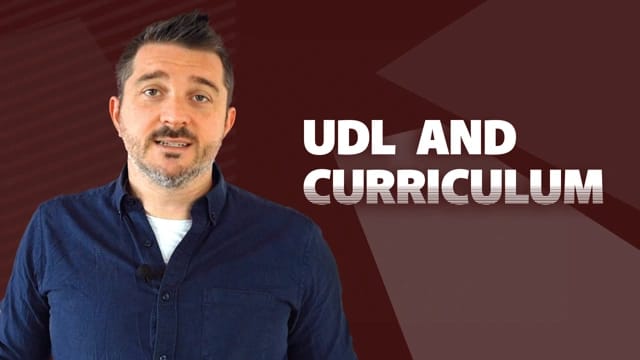How to create an effective lesson plan in 4 steps
In this guide
What is a lesson plan?
Just as a writer creates a plan for what they are creating, a teacher must create a plan for teaching. A lesson plan is an outline of a lesson. It includes the steps for the lesson, the instructional methods to be used, student differentiation needs, scaffolding techniques, questions to be asked, and assessments.
Different lessons may require different types of plans. Some lessons may require more extensive questioning, while others may require the teacher to provide greater levels of differentiation. Lesson planning can be modified to fit the needs of the students and the teacher.
Gradual release of responsibility
Lesson plans can take many forms. School districts often have specific requirements for what must be included. Regardless of a school’s requirements, one research-based way to develop a teaching lesson follows the “I do, we do, you do” or gradual release of responsibility model.
I do, we do, you do or the gradual release model can be used across subjects, year groups, and student abilities. It can be stretched across several lessons and may not necessarily all be accomplished in one.
This model is what it sounds like – a gradual release of responsibility for learning from the teacher to the students. The mental load shifts during this process from the teacher to the students.
I Do
The I Do part of the lesson plan is where the teacher does the teaching. This is where explicit instruction occurs. The teacher demonstrates the new skill, which they have broken down into small and understandable steps.
This part of a lesson plan is where the teacher will include the content – be it a Maths lesson, a History lesson, a Music lesson, or any other subject matter. Modelling and explaining belong in this section. The teacher shares the content knowledge.
We Do
Collaboration is the key to the We Do stage. Students collaborate with other students to apply the learning from the I Do stage.
This is where students may discuss the content in groups. If a lesson were overusing adjectives in sentences, for example. Students might use this time to create sentences with appropriate adjectives together on chart paper.
The We Do stage provides time for the students to collaborate, but also for the teacher to assess comprehension from the I Do lesson. The teacher should take time to observe, collaborate with, and provide feedback to students.
You Do
After the We Do phase, students move to the You Do phase. This is where students show what they have learned. This is independent practice. The I Do can take many forms. It is not always a formal assessment. Perhaps it is a written response, a quiz, a project, a demonstration of a skill, or an oral response.
The gradual release model fits into any lesson plan. Teachers can adjust it to meet their needs and the needs of their students.
In my own classroom, gradual release is typically how my lessons are structured. Most of my teaching career has been working with English language learners. Gradual release has proven to be a great way to stretch students’ skills, while also providing appropriate scaffolds.
When creating my own lesson plans, I include the “I do, We do, You do” outline and what each section will look like in practice. In Texas, we teach students to write a short constructed response that uses evidence from the text.
When teaching students to write a short constructed response, I would do an example for the students first. During the creation of this example, I would use a text we have read, present the writing prompt, and demonstrate how I would write my response for students. Then we would create one together using the same text, but a different prompt. Finally, students would write their own responses, using the same text but a different prompt.

Benefits of a lesson plan
There are several benefits to creating a lesson plan. These include the ability to purposefully include differentiation strategies and scaffolding techniques, an increase in teacher confidence, and allow for a teacher to reflect on their practice.
1) Differentiation
One benefit of a lesson plan is the teacher’s ability to include differentiation and scaffolding.
Learner diversity is present in every classroom. “Differentiation serves to address this variation by matching the content, instruction, and assessment to students’ needs and interests” (Reis, S. and Renzulli, J. The Five Dimensions of Differentiation).
Differentiation takes into account the needs of the students. A teacher can differentiate for various ways of learning, ability levels, and student interests. Regardless of what students need, the teacher can adjust instruction, assignments, and assessments to address those needs.
A lesson plan can include these differentiation steps. If a group activity is being planned, the students can be placed into appropriate groups. Questions can be levelled for different students’ ability levels. Assessments can be accommodated or modified according to individual student education plans.
This ClickView video discusses how differentiation can be addressed in the classroom.
2) Scaffolding
A second benefit of creating a plan for teaching is it allows the teacher to deliberately include scaffolding techniques. Scaffolding is “an instructional practice where a teacher gradually removes guidance and support as students learn and become more competent” (University at Buffalo).
Including scaffolding techniques within a lesson plan ensures that the teacher does not overlook student needs within their classroom. For example, if a teacher has English learners in their classroom they may choose to include several visuals to help with vocabulary.
I recently shared another blog that addresses specific scaffolding techniques for the classroom.
3) Decision-making
Trying something new in our classrooms is also not easy. Creating a lesson plan can increase teacher confidence. A plan can help a teacher maintain focus and reduce the number of unplanned decisions they must make in a day.
To reduce the number of unplanned decisions a teacher needs to make, a lesson plan is very effective. Thinking about what questions to ask, examples to give, what students to group together, what supplies are needed, etc. before the lesson reduces overall mental stress.
4) Reflection
Another benefit of a lesson plan is it gives the teacher an opportunity to reflect on their teaching and make any changes. Reflection and refinement are how teachers hone their teaching skills. They help us perfect the art of teaching.
In my own teaching practice, I have used reflection to become a better teacher. One example that comes to mind is when I was teaching 10-11-year-olds. That year was a particularly challenging year, with particularly challenging students. At the end of each week, I would spend about 10 minutes reviewing what had gone well and what needed to be adjusted. I would create a two-column chart like the one below. Using this reflection tool on a weekly basis helped me to see how my teaching was evolving, but also how my students were improving.
| What went well this week: | What needs work: |
| – Seating chart assignments for this week facilitated better student interactions, esp. Group 4 – Turn and Talk activity on Tuesday was useful data, will continue to include | – Attendance needs to be taken earlier – The transition between MFL and History needs to be shorter. – Start including exit tickets between subjects. |
Becoming better at our practice takes concerted effort. It requires thought and dedication to craft. It may seem like there is not enough time in the day for reflection. As a classroom teacher, I completely understand this feeling.
Choosing to reflect on specific lessons or only parts of a lesson, can limit this overwhelming feeling. Setting goals and then reflecting on lessons that specifically apply to those goals limits the time required for reflection.
This reproducible from Solution Tree can be useful in the reflection process. It includes space to record the results of the technique used and also modifications for future use.
4 Steps to creating a lesson plan
So, what steps should teachers take when creating a lesson plan? Below I have outlined four steps that can increase the effectiveness of a lesson plan and decrease the in-the-moment decision-making for a teacher.

Step #1: Learning objectives
Setting the learning objective is the first step in creating a lesson plan. Learning objectives are used by the teacher and the students. They help to focus the learning and set expectations.
“Learning objectives (LOs) are used to communicate the purpose of instruction. Done well, they convey the expectations that the instructor . . . has in terms of what students should know and be able to do after completing a course of study” (Orr, Csikari, Freeman, Rodriguez, 2022).
When setting the learning objective for any subject, the teacher must take into account how the LO links to the curriculum.
How does a teacher write a student-friendly learning objective? The place to start is with the verb found in the standard. As an example, I will use the English KS4 Curriculum:
“Pupils should be taught to write accurately, fluently, effectively and at length for pleasure and information through
- selecting, and using judiciously, vocabulary, grammar, form, and structural and organisational features, including rhetorical devices, to reflect audience, purpose and context, and using Standard English where appropriate”
This is a very wordy standard; when creating a student-friendly learning objective, it is important to use the verbs and vocabulary found in the curriculum. The verbs in this standard are selecting and using. This is because students are assessed at that level, so they need to understand that vocabulary.
Examples of student learning objectives from this standard:
- The student will use vocabulary and grammar for effect.
- The student will select a structure and organisation for effect.
- The student will use rhetorical devices (including simple, metaphor and personification.
- The student will appeal to the target audience through their writing.
Learning objectives help both the teacher and the students to focus the learning. Using this learning objective to set the purpose for learning allows students and teachers to know the expectations.
Step #2: Differentiation and scaffolding
Including differentiation and scaffolding in the lesson plan is vital for student success. Teachers need to know where students are and what they need.
Including both within a lesson plan ensures that a teacher is addressing student needs throughout the lesson. Addressing diverse student needs can sometimes feel like an overwhelming task. Including scaffolding and differentiation within the lesson plan can help to minimise this feeling.
This is where the teacher should include what visuals they are going to use to help explain vocabulary. Examples for students would also be included. If you are doing a Maths lesson over equivalent fractions, for example, you would want to include the problems you are going to model for students.
A teacher can also scaffold by including questions at different levels. This links to step #3. Including questions at various levels allows students at various levels to participate in class discussions.
If students need sentence starters or sentence frames to answer questions, the teacher can include these in the plan as well.
Differentiation has become an overused term in education. However, adaptive teaching practices can be a way of looking at differentiation in a new way. The focus of adaptive teaching practices is:
adapting lessons, whilst maintaining high expectations for all, so that all pupils have the opportunity to meet expectations
Eaton, 2022
Adaptive teaching requires a slight mind shift. Scaffolding, differentiation, and adaptive teaching work together to create a learning environment where all students can succeed no matter what their needs might be.
It is not just making a different worksheet for students because they need the support, but putting in the work so that all students can meet the required expectations. Formative assessment plays a part in this process and will be discussed further in Step #4.

Step #3: Questioning
Questioning is how we, as educators, push students to deeper thinking.
Questions are a way of engaging with students to keep their attention and reinforce their participation.
Questions can review, restate, emphasise, and/or summarise what is important. Questions stimulate discussion and creative and critical thinking, as well as determine how students are thinking.
Cornell University
Including the questions to be posed to students in the lesson plan is important. This is a way for a teacher to differentiate for various student needs because they can ask different levels of questions. It is also a way to spark thinking for conversation.
Including the questions also allows the teacher to lessen their mental load during the lesson delivery. Instead of trying to form questions off the top of their head, the teacher can focus on student responses.
Questioning can help to break the “I do” portion of the lesson into smaller chunks. Smaller chunks of learning make it easier for students to digest information. Questioning gives students processing time with a digestible amount of newly gained knowledge.
Providing students with adequate time to talk and express themselves is the best education practice. Students need time to engage with each other and with academic vocabulary. Giving students time to discuss and engage with the academic topic increases comprehension and retention.
“Planning for and implementing a short student talk sessions is one of the best ways to quickly reset attention” as well (Cain, Laird, Cotten, and Ellspermann 2021). The attention span of students, especially in recent times, has grown shorter. Short discussions allow students to refocus their learning. The overall mental load is reduced because they can refocus and address smaller chunks of information.
Questioning can also be a form of formative assessment. As students are engaging in talk, the teacher can circulate and gain an informal understanding of levels of comprehension. Questioning for assessment purposes leads us to the final step.

Step #4: Assessment
Planning for assessment should be a part of any lesson plan. Assessment can be formal or informal. Assessments can also be for learning (formative) or assessments of learning (summative).
How students are going to be assessed should be a part of every plan. Assessments may be quick – just a question or poll from the class. Or they may be more formal, as in a quiz at the end of a unit or an exit ticket as students leave.
Included in the lesson plan should be how the assessment data is going to be used. This is for the teacher’s knowledge.
Formative assessments are assessments in which “evidence about student achievement is elicited, interpreted, and used by teachers, learners, and their peers to make decisions about the next steps in instruction” (Solution Tree, 2018).
Formative assessment can even be used to adjust instruction in the moment. The teacher might present a question for students to discuss in pairs. As students are discussing, the teacher is listening in on these discussions. If the teacher realises that students are not responding appropriately, they can clarify misconceptions or confusion right away.
Assessments of learning, or summative assessments, help the teacher to evaluate student learning. These are most effective when they include some sort of written response, if appropriate for the students.
According to the Metropolitan State University of Denver, “Writing can help improve memory by creating deeper connections with subject material at the neurological level”. Writing about materials that have been learned aids students in retention. Students can think and respond more critically.
My favourite formative assessments are written response assessments. As a Reading and Language Arts teacher in the US, I think opportunities to write are always a great idea.
If we have been learning about descriptive sentences, for example, then I would have students write a descriptive sentence maybe as an exit ticket. Then I can take that and use it as a formative assessment.
This exit ticket will tell me if students have understood the lesson, but also what students may need extra support or are ready for a more challenging lesson.
I have also experienced creating formative assessments with my teaching team. These assessments were based on the curriculum. We often used the data from these assessments in our professional learning community (PLC). As a group, we would analyse these assessments and make plans for how to address learning gaps and for future lesson development.
Earlier in this article we briefly looked at adaptive learning practices. Adaptive learning “places a great emphasis on formative assessment” (Eaton, 2022). Adapting a lesson so that all students benefit and show mastery requires that we know where students are currently and what learning gaps may need to be addressed.
Together adaptive learning and formative assessments can transform our teaching and the way we plan.
Tips for better lesson planning
Creating a plan for teaching allows the teacher to focus the learning, plan for students’ needs, and prepare all aspects of the lesson. Lessons that have a dedicated plan can produce deeper and richer learning experiences for students.
- Make time for reflection. It is hard, but allowing this time is imperative. If it is easier, include it in your daily schedule.
- Many districts give a lesson planning template – but do not be afraid to make it your own. Include what you know students need.
- Recognise that the gradual release model may span several lessons, or may be repeated as needed.
- Do not be afraid to change your approach. Just because something has worked before, does not mean it will work the same again. Variety can enliven lessons.
- Recognise that practice improves performance. The more lesson plans that a teacher creates, the more they learn about what their students need and what enhances their teaching.
Use these videos on ClickView to support your lesson planning:
- How to Plan and Facilitate Brainstorming Online
- How to Plan and Facilitate Discussions in Online Classes
- How to Plan and Facilitate Online Problem Based Learning Tasks
- How to Use Universal Design for Learning to Design Lessons
- Building Relevance
Sources
- Cain, S., Laird, M., Cotten, S., and Ellspermann, J. (2021). The Fundamental 5 Revisited Exceptional Instruction in Every Setting. Monee, IL: Lead Your School.
- ‘Common Core State Standards for English Language Arts & Literacy in History/Social Studies, Science and Technical Subjects’ Common Core State Standards Available at https://learning.ccsso.org/wp-content/uploads/2022/11/ADA-Compliant-ELA-Standards.pdf (Accessed April 28, 2024)
- Eaton, Jon. (2022) “Guest Blog: Jon Eaton, Director of Kingsbridge Research School and Research Lead at Kingsbridge Community College, reflects on what adaptive teaching has meant for their Trust, Education Southwest.” Available at https://educationendowmentfoundation.org.uk/news/moving-from-differentiation-to-adaptive-teaching (Accessed May 8, 2024).
- Free Resources Solution Tree. (2024) Available at https://www.solutiontree.com/free-resources (Accessed April 26, 2024)
- Orr, R., Csikari, M., Freman, S., and Rodriguez, M. (2022) ‘Writing and Using Learning Objectives’ CBE Life Sciences Education 21(3) doi: 10.1187/cbe.22-04-0073
- Reis, S. and Rezulli, J. (2018) “The Five Dimensions of Differentiation” International Journal for Talent Development and Creativity, 6(1) and 6(2) https://www.ncbi.nlm.nih.gov/pmc/articles/PMC9582829/ (Accessed April 28, 2024)
- Solution Tree Press (2018). The handbook of Embedded formative assessment. Bloomington, IN: Solution Tree Press.
- Texas Essential Knowledge and Skills’ Texas Education Agency. (2019). Available at: https://tea.texas.gov/academics/curriculum-standards/teks-review/texas-essential-knowledge-and-skills (Accessed April 28, 2024)
- University at Buffalo, No date. Scaffolding Through Design. https://www.buffalo.edu/catt/teach/develop/build/scaffolding.html (Accessed April 27, 2024)
- ‘Using Effective Questions’ Cornell University (2024) Available at https://teaching.cornell.edu/using-effective-questions (Accessed April 28, 2024).
- ‘Writing as a Thinking Tool’ Metropolitan State University of Denver (No Date) Available at https://www.msudenver.edu/writing-center/faculty-resources/writing-as-a-thinking-tool/ (Accessed April 27, 2024)

Mattie Farrer
briefcase iconAVID Site Coordinator / Content Curator
Mattie Farrer has been an educator in various grade levels and capacities during her career. She has a passion for supporting English learners and their language development. She also loves helping teachers reach all students.
Other posts
Want more content like this?
Subscribe for blog updates, monthly video releases, trending topics, and exclusive content delivered straight to your inbox.













